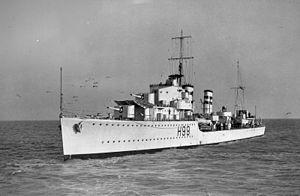 Hero during the Interwar period
| |
| History | |
|---|---|
| Name | Hero |
| Builder | Vickers-Armstrongs, High Walker |
| Yard number | 4 |
| Laid down | 28 February 1935 |
| Launched | 10 March 1936 |
| Commissioned | 23 October 1936 |
| Identification | Pennant number: H99 |
| Fate | Transferred to the Royal Canadian Navy on 15 November 1943 |
| Name | Chaudière |
| Commissioned | 15 November 1943 |
| Decommissioned | 17 August 1945 |
| Stricken | 19 March 1946 |
| Honours and awards |
|
| Fate | Sold for scrap in 1950 |
| General characteristics as built | |
| Class and type | H-class destroyer |
| Displacement | |
| Length | 323 ft (98.5 m) |
| Beam | 33 ft (10.1 m) |
| Draught | 12 ft 5 in (3.8 m) |
| Installed power | 34,000 shp (25,000 kW) |
| Propulsion |
|
| Speed | 36 knots (67 km/h; 41 mph) |
| Range | 5,530 nmi (10,240 km; 6,360 mi) at 15 knots (28 km/h; 17 mph) |
| Complement | 137 (peacetime), 146 (wartime) |
| Sensors and processing systems | ASDIC |
| Armament |
|
HMS Hero was an H-class destroyer built for the Royal Navy in the mid-1930s. During the Spanish Civil War of 1936–1939 the ship enforced the arms blockade imposed by Britain and France on both sides as part of the Mediterranean Fleet. During the first few months of World War II, Hero searched for German commerce raiders in the Atlantic Ocean and took part in the Second Battle of Narvik during the Norwegian Campaign of April–June 1940 before she was transferred to the Mediterranean Fleet in May where she escorted a number of convoys to Malta. The ship took part in the Battle of Cape Spada in July 1940, Operation Abstention in February 1941, and the evacuations of Greece and Crete in April–May 1941.
The ship covered an amphibious landing during the Syria–Lebanon Campaign of June 1941 and began escorting supply convoys in June to Tobruk, Libya shortly afterwards. She was damaged by German dive bombers while rescuing survivors from the minelayer Latona in October 1941 and resumed escorting convoys to Malta. Hero took part in the Second Battle of Sirte in March 1942 and in Operation Vigorous in June. She sank two German submarines whilst stationed in the Mediterranean in 1942, and was transferred back home late in the year to begin converting to an escort destroyer. The ship was transferred to the Royal Canadian Navy (RCN) in 1943 and renamed HMCS Chaudière. She became part of the Mid-Ocean Escort Force in early 1944 until her transfer back to British coastal waters in May to protect the build-up for Operation Overlord. Together with other ships, she sank three more German submarines during the year. Chaudière was refitting when the war ended in May 1945 and was in poor shape. The ship was paid off in August and later sold for scrap. The process of breaking her up, however, was not completed until 1950.